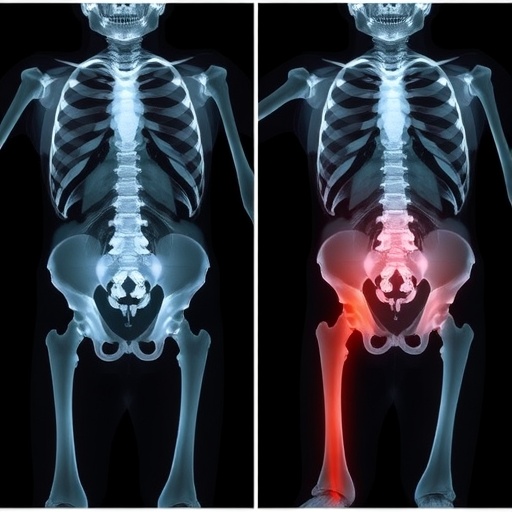In a remarkable study recently published in the realm of pediatric radiology, researchers have unveiled two captivating cases concerning the retropsoas appendix vermiformis, a rarely encountered anatomical anomaly. The findings were born out of meticulous examination through computed tomography (CT) scans, showcasing the intricate relationship between anatomical variations and diagnostic imaging. The peculiarity of this condition lies not just in its rarity but in the potential implications for clinical practice, particularly in pediatric populations where precise diagnosis is paramount.
The investigation conducted by Pehlivan and Huseynov reveals how variations like the retropsoas appendix can transcend typical surgical and diagnostic expectations. Pediatric cases, while often routine, present unique challenges that demand a high degree of attention from radiologists and healthcare professionals alike. Understanding these nuances can drastically improve diagnosis accuracy, ensuring that conditions are not overlooked in young patients who might lack the ability to articulate their symptoms.
One of the key facets of this study is the emphasis on the role of advanced imaging techniques. Computed tomography stands out as a non-invasive method that provides high-resolution images crucial for identifying anatomical anomalies. The detailed cross-sectional images obtained through CT scans enable radiologists to visualize structures that may be obscured during traditional examinations. This becomes especially critical in pediatric health, where anatomical variations can lead to misdiagnosis and improper treatment plans if not accurately assessed.
The discovery of the retropsoas appendix vermiformis in these pediatric cases highlights a key educational opportunity within the medical community. It serves as a reminder of the diverse anatomical landscape practitioners must navigate in their clinical practice. Radiologists are encouraged to hone their skills in recognizing such anomalies, which will ultimately enhance their diagnostic acumen and patient outcomes. The cases presented in this study not only emphasize the need for continuous education but also the importance of collaborative discussions amongst pediatricians and radiologists.
Furthermore, one cannot underestimate the implications of such findings on surgical planning. When anomalies like the retropsoas appendix are identified, the surgical approach may need significant reevaluation. Surgeons operating on pediatric patients must be aware of potential variations in anatomy that could complicate procedures. This study serves as a narrative to underscore how incorporating knowledge of such anomalies can facilitate more effective and safer surgical interventions.
The diagnostic process also extends far beyond the identification of anomalies. It involves synthesizing a multitude of factors, including patient history, clinical presentation, and imaging studies. The retropsoas appendix vermiformis could easily be dismissed if a thorough investigation is not conducted. This study effectively reinforces the necessity of a comprehensive approach to patient evaluation, shedding light on the importance of radiologists’ intuition in discerning between normal and aberrant structures.
Pediatric cases often challenge the limits of medical understanding, necessitating innovative approaches and a commitment to ongoing research. The findings of this study advocate for a robust dialogue within the medical community, highlighting the synergy between radiology and surgery in effectively managing children’s health. By fostering a culture of inquiry and collaboration, healthcare professionals can push the boundaries of existing knowledge, ultimately leading to improved patient care.
The unique nature of the retropsoas appendix provides a fascinating glimpse into the human anatomy’s complexity. As an anatomical variant, it embodies the diversity found within our bodies. Educating future generations of medical professionals about such peculiarities will be crucial. It empowers them to navigate the technicalities of human anatomy with confidence and precision, which will be instrumental in their medical endeavors.
Moreover, the cases prompt us to consider the implications of such anomalies on our understanding of embryological development. The retropsoas position of the appendix may relate to various developmental processes that warrant further exploration. As researchers delve into the intricacies of human fetal development, uncovering how such anatomical positions arise could pave the way for significant insights into congenital variations and their clinical manifestations.
In a world where clinical excellence is defined by precision, this study exemplifies the relentless pursuit of knowledge that characterizes the medical field. Each case adds another layer to our understanding of normal and abnormal anatomy, gradually enriching the tapestry of medical science. As we continue to unravel the complexities of human anatomy, pediatric cases such as those discussed herein make significant contributions to both education and clinical practice.
Ultimately, the retropsoas appendix vermiformis serves as a beacon of curiosity within the expansive field of pediatric medicine. It compels radiologists and surgeons to maintain a vigilant awareness of anatomical diversity while serving to inspire future research. As medical professionals, the willingness to delve into the unknown could lead to breakthroughs that not only enhance individual practices but also contribute profoundly to the broader field of medicine.
In conclusion, as more studies like this emerge, the continued exploration of anatomical anomalies promises to yield invaluable insights that transcend conventional medical knowledge. The pediatric population, particularly, stands to benefit from the cumulative wisdom gained through diligent research and clinical practice. Pehlivan and Huseynov’s case findings are thus not merely academic; they represent stepping stones towards enhanced patient care through understanding, appreciation, and recognition of the marvel that is human anatomy.
Subject of Research: Retropsoas appendix vermiformis in pediatric cases detected via computed tomography.
Article Title: Retropsoas appendix vermiformis: two incidentally detected pediatric cases on computed tomography.
Article References:
Pehlivan, U., Huseynov, M. Retropsoas appendix vermiformis: two incidentally detected pediatric cases on computed tomography.
Pediatr Radiol (2025). https://doi.org/10.1007/s00247-025-06450-9
Image Credits: AI Generated
DOI: https://doi.org/10.1007/s00247-025-06450-9
Keywords: Retropsoas appendix vermiformis, pediatric radiology, computed tomography, anatomical anomalies, surgical implications.




